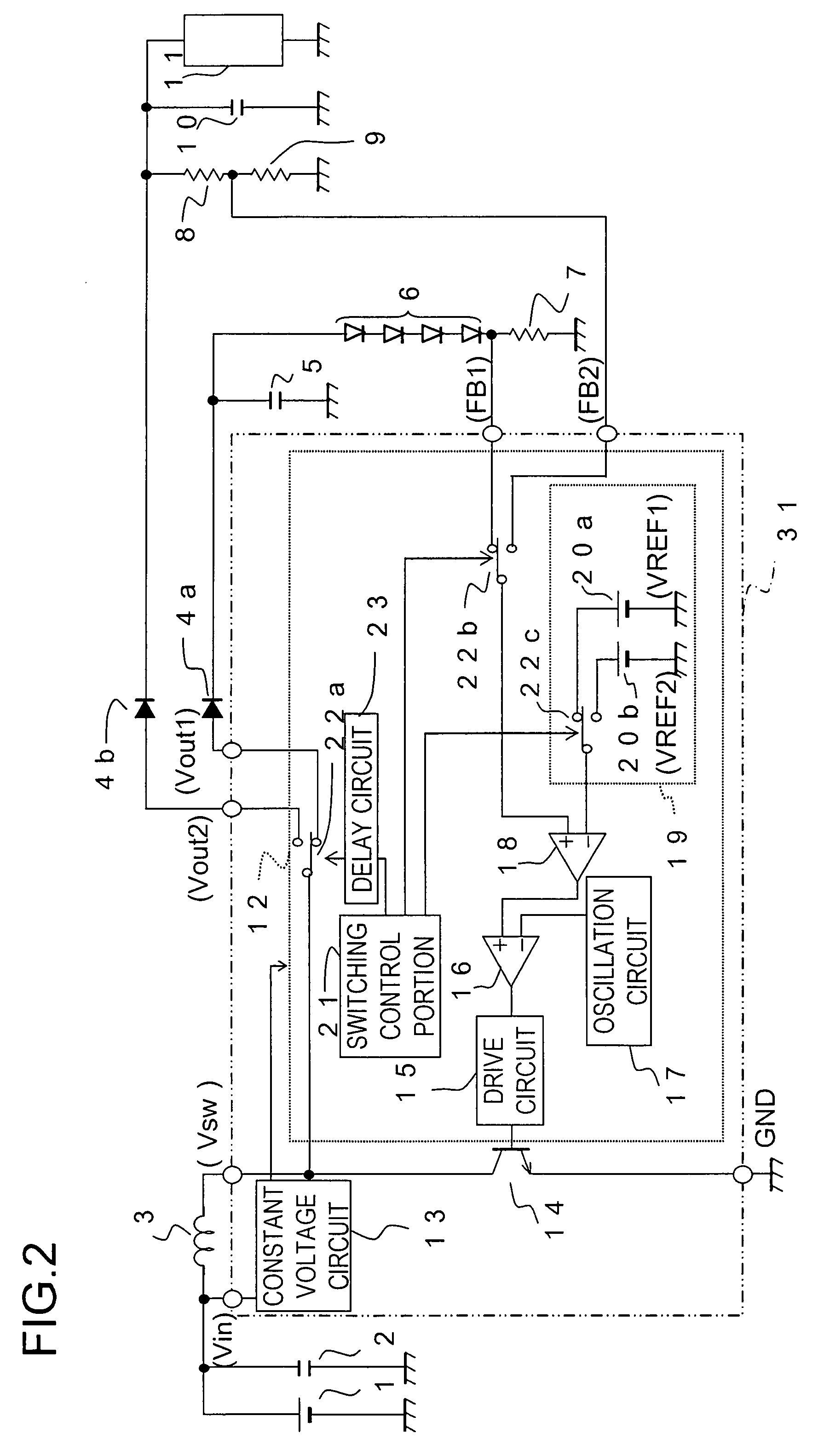Chopper regulator circuit
a regulator circuit and regulator technology, applied in the direction of circuit arrangement, static indicating device, instruments, etc., can solve the problems of difficult to make each one of them emit light properly, large variation of drive voltage of organic el elements, and high power loss of resistors b>7/, so as to reduce damage and other adverse effects.
- Summary
- Abstract
- Description
- Claims
- Application Information
AI Technical Summary
Benefits of technology
Problems solved by technology
Method used
Image
Examples
first embodiment
[0056]Embodiment 1: As the present invention, a chopper-regulator-type power supply circuit will be described below that is connected to an LED group (which may be a single LED, or a plurality of LEDs connected in series) and an organic EL element to supply electric power selectively to one of them. The configuration of this power supply circuit is shown in FIG. 1.
[0057]As shown in FIG. 1, the power supply circuit includes a DC (direct-current) power source 1, an input capacitor 2, a coil 3, a first diode 4a, a second diode 4b, a first output capacitor 5, resistors 7 to 9, a second output capacitor 10, a chopper regulator IC 31, and other components. Configured as shown in FIG. 1, the power supply circuit supplies the LED group 6 and the organic EL element 11 with electric power.
[0058]The negative terminal of the DC power source 1 is grounded, and the positive terminal of the DC power source 1 is connected to one end of the input capacitor 2 and to one end of the coil 3. The other e...
embodiment 1
[0075]As described above, the power supply circuit of Embodiment 1 is a chopper-regulator-type power supply circuit that is connected to an LED group 6 and an organic EL element 11 to supply them with electric power. The power supply circuit includes components (such as a DC power source 1 and a coil 3) for outputting electric power to those loads, components (such as a resistor 7) for detecting as a detected voltage the current outputted to the LED group 6, and components (such as resistors 8 and 9) for detecting as a detected voltage the voltage outputted to the organic EL element 11.
[0076]The power supply circuit further includes a first and a second reference voltage source 20a and 20b for generating reference voltages VREF1 and VREF2 respectively and components (such as a drive circuit 15, a PWM comparator 16, and an error amplifier 18) for comparing two input voltages to control, based on the result of the comparison, the amount of outputted electric power.
[0077]The power supp...
embodiment 2
[0081]This makes it possible, without complicating the control performed by the switching control portion 21, to perform the switching (input switching) between sources from which to obtain the voltage to be fed back and between reference voltage sources 20a and 20b properly prior to the switching (load switching) between destinations to which to supply electric power. Thus, even when electric power starts to be supplied before the feedback voltage sources and the reference voltage sources 20a and 20b are properly set (ready to operate), with Embodiment 2, it is possible to prevent instability in the control of the supply of electric power as much as possible.
[0082]Embodiment 3: Next, as a third embodiment of the present invention, again, a power supply circuit will be described below. The configuration here is largely the same as that in Embodiment 1, the chief difference lying in the configuration of the reference voltage circuit 19. Accordingly, no overlapping description will be...
PUM
 Login to View More
Login to View More Abstract
Description
Claims
Application Information
 Login to View More
Login to View More - R&D
- Intellectual Property
- Life Sciences
- Materials
- Tech Scout
- Unparalleled Data Quality
- Higher Quality Content
- 60% Fewer Hallucinations
Browse by: Latest US Patents, China's latest patents, Technical Efficacy Thesaurus, Application Domain, Technology Topic, Popular Technical Reports.
© 2025 PatSnap. All rights reserved.Legal|Privacy policy|Modern Slavery Act Transparency Statement|Sitemap|About US| Contact US: help@patsnap.com



